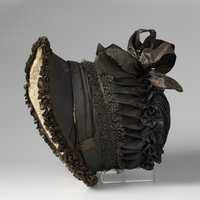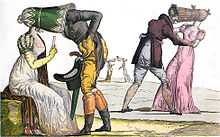Poke bonnet


A poke bonnet is a women's bonnet, featuring a deep, stiffened brim around the top and sides of the face. In different styles the crown might sit on top of the head or at the back of the head, and the shape of the brim would vary accordingly. A poke bonnet performed the dual functions of shading the wearer's face from the darkening effects of the sun and of concealing her face for the purpose of modesty or anonymity. It was usually secured by ribbons tied under the chin, which might also wrap around the bottom of the bonnet's crown, similar to a hatband.
The poke bonnet came into fashion at the beginning of the 19th century and remained stylish for almost a century. The "poke" in the name is a bag or sack. This meaning of poke is now archaic in standard English, but is preserved in regional varieties of English and in the expression "to buy a pig in a poke", an ancient symbol of consumers' behavior which unnecessarily puts them at risk of fraud.
By the 1830s, Englishwomen had adopted the poke bonnet. The new styles rendered the aristocracy less visibly distinct from the respectable middle classes than they had ever been.[1] The style is modest and was in line with English fashions after the ascension of Queen Victoria.[2]
A poke bonnet features prominently in the illustrations of Beatrix Potter's Tale of Jemima Puddle-Duck. Another appears in the first-world-war-era music hall song "In your little poke bonnet and shawl".
See also
References
- ↑ Judith S. Lewis (2003). Sacred to Female Patriotism: Gender, Class, and Politics in Late Georgian Britain. p. 184. ISBN 0415944112.
- ↑ Metropolitan Museum of Art, Mourning Poke Bonnet Collection.
| Wikimedia Commons has media related to Bonnets. |